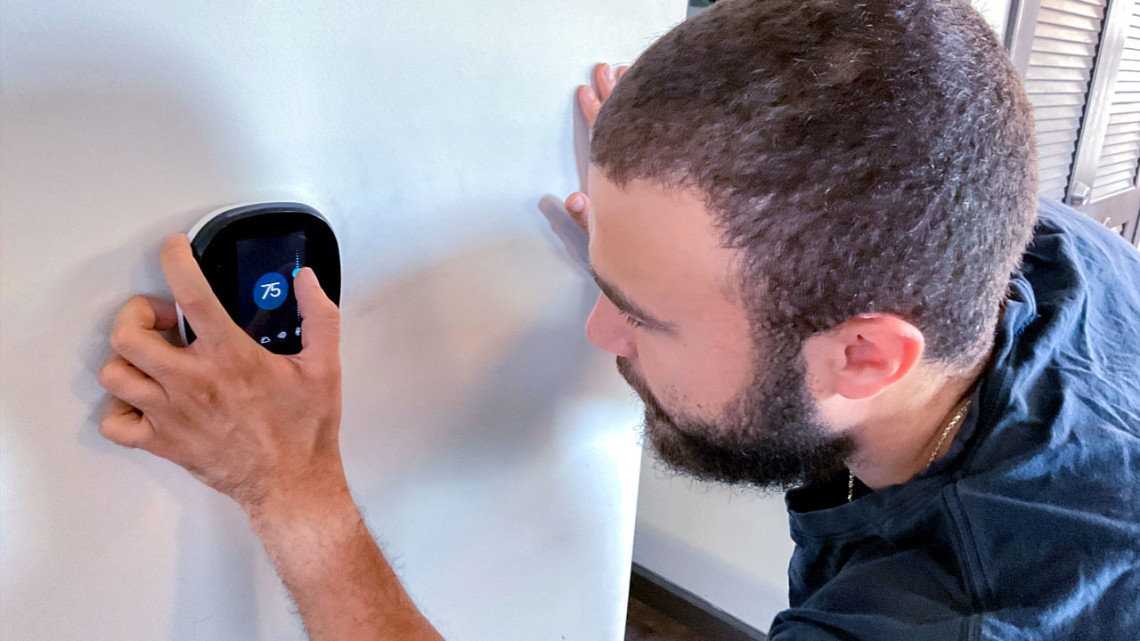
Alfredo Rodriguez, a doctoral student in engineering who conducts research with Max Zhang, adjusts a smart thermostat.
Smart thermostats inadvertently strain electric power grids
By Blaine Friedlander, Cornell Chronicle
Smart thermostats – those inconspicuous wall devices that help homeowners govern electricity usage and save energy – may be falling into a dumb trap.
Set by default to turn on before dawn, the smart thermostats unintentionally work in concert with other thermostats throughout neighborhoods and regions to prompting inadvertent, widespread energy-demand spikes on the grid.
The smart thermostats are saving homeowners money, but they are also initiating peak demand throughout the network at a bad time of day, according to Cornell engineers in a forthcoming paper in Applied Energy (September 2022.)
“Many homes have their smart thermostats turn down temperatures at night in the winter,” said Max Zhang, a professor in Cornell’s Sibley School of Mechanical and Aerospace Engineering and the Kathy Dwyer Marble and Curt Marble Faculty Director at the Cornell Atkinson Center for Sustainability. “The temperature can be programmed to ramp up before you wake up – and you’ll have a warm house. That’s the smart thing to do. But if everyone keeps their default setting, let’s say 6 a.m., the electric grid suffers synchronized demand spikes and that’s not smart for the system. That’s the challenge.
“As we electrify the heating sector to decarbonize the grid,” he said, “this so-called load synchronization will become a problem in the near future.”
Zachary E. Lee, Ph.D. ’22, is a co-author of the paper, “Unintended Consequences of Smart Thermostats in the Transition to Electrified Heating.”
In 2021, about 40% of U.S. homes had smart thermostats, as utilities encourage adoption, according to the paper. Lee and Zhang examined wintertime smart thermostat data for over 2,200 homes in New York state, noted for its cold winter climate and a mix of urban, suburban and rural communities.
Homeowners purchasing a smart thermostat can opt to share their data anonymously with electric utilities for research purposes.
Lee and Zhang investigated “setpoint behavior” and learned that most homeowners use the smart thermostat’s factory-default settings. Evidence showed that residents remain confused about how to operate their thermostats and are often unable to program it, the authors said.
In fact, their data indicates homeowners achieved energy savings of only 5% to 8%, far less than the devices’ potential of 25% to 30%, Lee said.
If hundreds of homes have their smart thermostat set to turn on at 6 a.m., the electric grids see a peak at 6:05 a.m., which is about an hour before daylight during New York state winters.
While the setpoint schedules are designed to achieve the energy-saving benefit, the peak demands are concentrated primarily when renewable energy is unavailable – aggravating the peak demand by nearly 50%, according to the paper.
“The smart thermostat data shows both an increase in frequency of high daily peak heating demand,” Lee said, “as well as an increase in the magnitude of the overall peak demand.”
Without a tenable way to store energy from renewable sources like solar power, the electric utilities will be unable to supply this peak demand, which prompts fossil-fuel generators to satisfy the power load. “This can offset the greenhouse gas emissions benefit of electrification,” Lee said.
Zhang noted ways to address the growing pressure on the grid, such as educating consumers on how to use smart thermostats and staggering the morning ramp-up times. “The problem is not straightforward, due to the security and privacy issues involved with homeowners,” Zhang said. “In the end, however, we have to make smart thermostats even smarter.”
The National Science Foundation funded the work.
Media Contact
Get Cornell news delivered right to your inbox.
Subscribe

